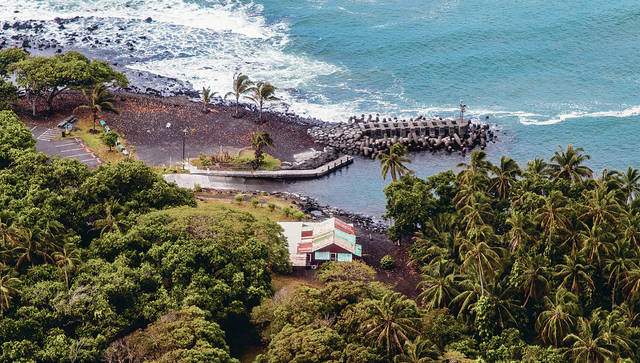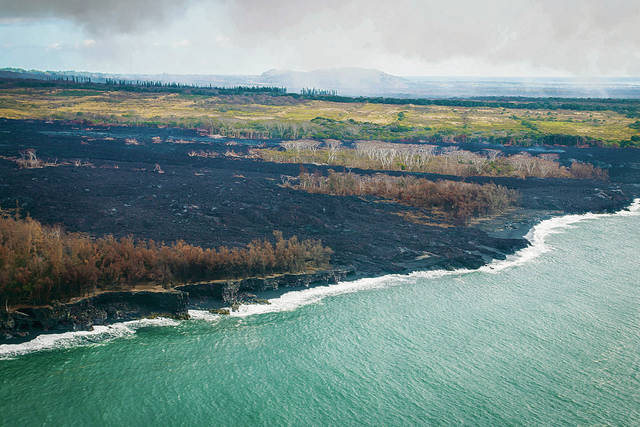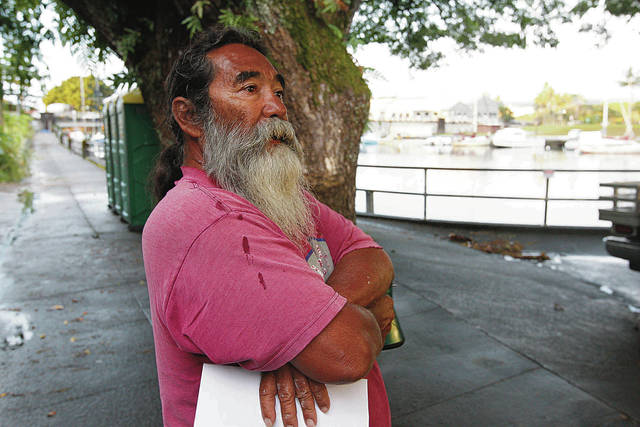Lava has blocked road access to favorite shoreline sites

COURTESY RICHARD DRAKE / DLNR
An aerial photo taken Thursday shows Pohoiki Boat Ramp undamaged by lava but cut off from users who want to launch from there. Pohoiki was heavily used by fishermen as well as for recreational boating, personal watercraft and other ocean activities.

COURTESY RICHARD DRAKE / DLNR
The 13-acre MacKenzie State Recreation Area, seen in an aerial photo taken Thursday, lies adjacent to the area where lava first entered the ocean.

COURTESY RICHARD DRAKE / DLNR
Access to Isaac Hale Beach Park has been cut off by lava flows, as shown in this aerial photo taken Thursday.

GEORGE F. LEE / GLEE@STARADVERTISER.COM
Big Island fisherman Sidney Masaoka, 65, of Hawaiian Beaches, has been hurt by the closure of the pier in Pohoiki.




HILO >> A stoic Sidney Masaoka sipped from a coffee mug as he stood near the outdoor scales at Suisan Fish Market in Hilo. It was just after sunrise and he had brought in five ahi totaling about 100 pounds.
Although he described his overnight haul as “decent,” the longtime Puna fisherman looked unhappy. Since lava from the ongoing Kilauea Volcano eruption blocked access roads to the Pohoiki Boat Ramp 30 miles southeast of Hilo, Masaoka has been trailering his 24-foot vessel to the Wailoa Boat Harbor in Hilo to head out to his usual fishery.
“Now I have to tow my boat over here and then go all the way back over to fish,” he said Friday. “It’s costing me a lot of money.”
Now more than ever, Masaoka and other Puna residents could use a break from the gloom that hangs over the rural eastern district of Hawaii island, where at least 637 homes have been destroyed and hundreds of people displaced by volcanic activity that started May 3.
>> Explosion shakes Kilauea’s summit
>> Volcanic activity destroying marine and forest preserves
>> State leaders should be devising plans now to help volcano-impacted businesses recover
RELATED PHOTOS AND VIDEOS
>> Live webcams from Hawaii island
>> Lava river in Leilani Estates, June 23
>> Fissure 8 channel transports ‘lava boats’
>> Lava on Moku Street in Leilani Estates, June 21
>> Vigorous lava flow from fissure 8 to ocean, June 19 Opens in a new tab
>> Gas plume above Halemaumau Crater, June 18 Opens in a new tab
>> Hawaii National Guard lava river flyby, June 16 Opens in a new tab
>> Kalapana Night Market provides needed lava break for residents, June 16
>> Newly opened center is a one-stop shop for Kilauea disaster survivors on Hawaii island, June 15
>> Dramatic footage from Kilauea’s most active fissure: No. 8, June 15
>> Pahoa business owners talk about drop in business, June 14
COMPLETE KILAUEA COVERAGE
>> Star-Advertiser volcano coverage
>> Kilauea Volcano YouTube playlist
Don't miss out on what's happening!
Stay in touch with breaking news, as it happens, conveniently in your email inbox. It's FREE!
But they can no longer find relief at favorite nearby shoreline sites where they used to camp, picnic, fish, swim and surf.
Although Hawaii County’s Isaac Hale and Ahalanui beach parks were spared by lava, they are inaccessible for the foreseeable future. Situated within Isaac Hale Beach Park on the northern end of Pohoiki Bay, the Department of Land and Natural Resource’s Pohoiki Boat Ramp also is undamaged but cut off from users who want to launch from there.
Steve Schmelz, district manager for DLNR’s Division of Boating and Ocean Recreation on the Big Island, said boaters have approached the 18-foot-wide ramp by sea to check on their property, retrieve belongings and rescue animals trapped by lava flows, but “there’s no way to get down there.”
Pohoiki was heavily used for recreational boating, personal watercraft and other ocean activities. Since the shoreline at Isaac Hale Beach Park is rocky, it was also an entry to the water for swimmers and surfers, even though they aren’t supposed to be there for safety reasons, Schmelz said.
Conflicts between boaters and swimmers were not unusual, he said, and the Legislature had approved funding to study the problem.
DLNR doesn’t track how many boaters utilize the ramp, according to Schmelz, but four companies hold commercial permits for Pohoiki and were running lava-viewing tours. DLNR offered the tour boats a chance to relocate to the Wailoa Harbor ramp in Hilo, and two of the larger vessels secured transient dock slips there for up to 120 days.
Using Wailoa instead of Pohoiki means added fuel costs and travel time to get passengers to coastal lava-entry points at Kapoho Bay.
Hawaiian Lava Boat Tours owner and commercial fisherman Kainoa Hauanio is dealing with the double whammy of having lost his Leilani Estates house to the eruption and now seeing his livelihood threatened by not being able to launch from the Pohoiki Boat Ramp. He estimates he uses 45 gallons of marine fuel running out of Wailoa compared to 21 gallons when he launches from Puna.
“It’s double the distance, double the gas — everything is double pretty much,” said Hauanio, who was eating breakfast at the Suisan Fish Market Friday.
Hauanio said he is staying with friends in Kau with his wife and three children, including a newborn. When he wants to fish, he makes the two-hour drive from the southern end of the island to a friend’s house in Makuu, outside Pahoa, where he’s been leaving his boat. From there, he trailers to the Wailoa Boat Ramp, and then it’s an hour and a half to two hours on the water to get to his usual fishing grounds.
He said he prefers fishing off Pohoiki and Kalapana rather than outside Hilo Bay. “Here it’s at least 5 miles before you let out your lines because the water’s so shallow and there are so many boats,” Hauanio said. On a busy day at Pohoiki, there were maybe only 10 other boats launching, he said.
Even off the Puna coast he’s had to fish farther out to sea because the eruption has turned the ocean green in some places and fish are more scarce.
When the Pohoiki ramp was open, the 65-year-old Masaoka said he would either head out several miles toward Kalapana to troll for ahi or ono or stay closer to shore to snag menpachi.
The Hawaiian Beaches resident recalled maintaining a large campsite at Isaac Hale Beach Park where fishermen would hang out and sleep during the day before their night runs.
“For me, I live there (in Puna) and it’s right there, and the fish are just 10 minutes out,” he said.
Blocked access
Because Hawaii island is relatively young, in geological terms, much of its shoreline comprises sheer cliffs and craggy lava outcroppings. Sandy beaches and other shoreline recreational sites are at a premium, especially in Puna, home to Kilauea’s volatile East Rift Zone.
A geothermal source from the volcano heats natural pools at the county’s Ahalanui Beach Park, also known as Hot Ponds, which lies about a mile northeast of Isaac Hale Beach Park. Lava-blocked roads are denying tourists and locals access to the spot, which was manned by county lifeguards.
Also closed is 13-acre MacKenzie State Recreation Area, south of Pohoiki Bay and adjacent to the area below the Lanipuna Gardens subdivision where lava from the Kilauea eruption first entered the ocean. The coastal park allows for picnicking and shore fishing and is traversed by an old Hawaiian trail.
Due to safety concerns, MacKenzie has been closed since shortly after the eruption began and likely will remain so “for a very long time,” said DLNR Parks Division Administrator Curt Cottrell in a statement.
“Pele is in control now. She already reclaimed Kalapana State Park back in 1990 and may well decide to perform substantial makeovers” to MacKenzie, he said.
The Kalapana lava flows of the 1990s south of MacKenzie also consumed some of the island’s best surfing spots, and now surfers are mourning the loss of access to a series of choice breaks at Pohoiki Bay.
Board shaper Stan Lawrence, who owns Orchid Land Surfboards on the Hilo Bayfront, said Pohoiki creates one of the largest south-swell waves in the state, as high as 15 feet. The bay also catches east and wrap-around swells from the north.
“There’s always something to ride. It’s rare when there aren’t waves,” he said.
“It’s a very important spot for Puna and Hilo, and, of course, you can’t go there now,” said Lawrence, 70, who has been surfing off Puna since the early 1970s. “This island is a baby in geologic terms, and we don’t have many surf spots.”
The conditions challenge even experienced surfers, he said, and inside rocks add to the danger. Third Bay is the most famous break, but other popular surf spots include First Bay, more suitable for young surfers; Second Bay and Dead Trees or Pavilions.
Lawrence, who opened his business in 1972, said Pohoiki Bay gained prominence after lava wiped out Kalapana’s “world-class” breaks, which included Left Point and Drain Pipes (“magic” is how he described the latter).
“Now it’s happening all over again. It’s the same thing,” he said.
The closure of Isaac Hale Beach Park at Pohoiki Bay is likely to cause overcrowding at Honolii in Hilo, the only other main break in East Hawaii, according to surfers interviewed by the Star-Advertiser.
One last day at the beach
Puna residents got a brief respite from their volcano woes when Mayor Harry Kim opened Isaac Hale Beach Park for one day only on the Memorial Day holiday, May 28.
“The mayor wanted to be able to allow one last day at the beach, and everyone got to go down and enjoy the beach,” said Maurice Messina, deputy director of the county’s Department of Parks and Recreation.
“Unfortunately, the next day lava came and cut off the roads.”
With Kilauea’s fissure 8 steadily pumping out lava in the lower East Rift Zone, Messina said it’s too early to know when — or if — access to the Puna parks via Pohoiki Road and Kalapana-Kapoho Beach Road will be restored.
“The park has not been covered by lava, and the mayor’s goal is always to allow Parks and Recreation to provide our services. But it’s premature to say when that might happen.”
“These are very popular Lower Puna beach access points,” Messina said. “It’s saddening for this beautiful beach to be cut off. As soon as the lava stops, hopefully one day we will be able to get access again.
“Surfers have lost their No. 1 spot.”
Schmelz also is hopeful the access roads to Isaac Hale Park will reopen at some point.
“It’s an important recreational facility for the people who live there. Between the state and county government, they’ll figure out a way when it’s safe to do it,” he said.






